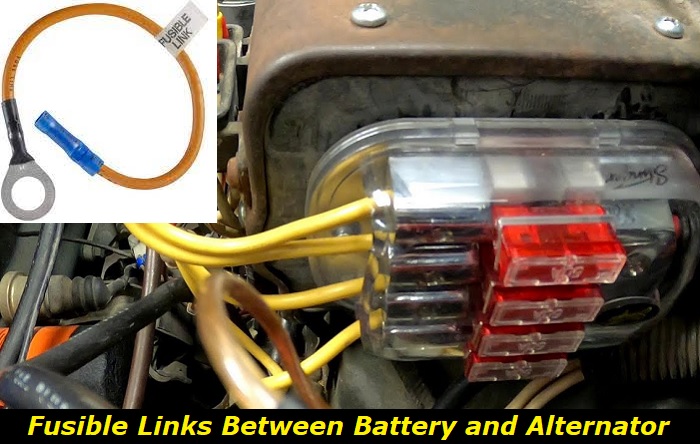Fusible links are important components of the alternator-battery system in a vehicle. They act as safety devices, protecting the electrical circuits from excessive current flow and potential damage.
Car battery issues highlights
- Possible reasons:battery age, driving conditions, drains, long sitting, electrical problems
- Types affected:all types
- Average age:4-5 years
- Most commonissues:low voltage, no crank, battery light, glitchy electronics
- Can you drive?only if it starts
- DIY fix:possible
- How much to fix?$150 - $250

What is an alternator, and why is it important?
An alternator is an electrical generator used to provide power in a vehicle. It typically operates by converting mechanical energy from the engine into electricity, which can be used to power the car's lights, ignition, and other accessories.
The alternator also helps to maintain a healthy charge in your car's battery and can help prevent it from discharging too quickly. Without an alternator, it would be difficult to keep the vehicle running for any significant length of time as the battery would not provide enough power.
How does a fusible link protect your car from damage?
A fusible link is a device that acts as an electrical fuse and provides protection for your car's electrical system from overloads and short circuits. The fusible link works by breaking the circuit when too much amperage flows through it, thus preventing further damage to the wiring and other components connected to the circuit.
These links are typically made of a special alloy that is designed to melt at a specific temperature. When too much current passes through the link, it causes it to heat up and eventually melt, breaking the circuit. This prevents damage to your car's wiring and other components connected to the circuit by not allowing an excessive amount of power to be passed through them.
A fusible link is an important component of your car's electrical system because it helps to ensure that your car runs safely and reliably. Without it, you may be at risk of damage due to electrical overloads or short circuits. Therefore, it is important to replace a fusible link whenever necessary in order to keep your car running smoothly.
How to locate a fusible link?
Locating a faulty fusible link can be difficult as they are usually hidden away within the wiring harness or located behind other components in the engine bay. However, checking some of the most common areas can help to narrow down where the problem might be occurring.
- Where to find a fusible link between alternator and battery in older cars?
In older cars, the fusible link between the alternator and battery can usually be found in one of two places. The first place to check is near the battery. Many vehicles have a small plastic box with a lid that houses the fusible links for both systems. The second place is under the hood, usually near the firewall.
- Where to find a fusible link between alternator and battery in newer cars?
In newer cars, the fusible link between the alternator and battery is usually located in the fuse box. On some vehicles, this may be near the engine bay or even behind a plastic cover. Check your owner's manual for specific information on where to locate the fusible link in your vehicle.
Symptoms of a bad fusible link
A bad fusible link can present a number of symptoms, ranging from minor to severe. Some of these include failure to start the vehicle, intermittent engine stalling or misfiring, electrical accessories not working properly, and an illuminated Check Engine Light.
In addition, you may notice that the battery is draining quickly or your headlights are flickering. If you experience any of these symptoms, it is important to have the fusible link inspected as soon as possible to prevent further damage from occurring.
In some cases, a bad fusible link can cause extensive damage to other components and result in costly repairs if left unchecked. Taking preventative measures now could save you time and money in the future.
If you are unsure of whether or not your fusible link has gone bad, there are a few easy tests that can be conducted to help diagnose the problem. A visual inspection of the wire is recommended to check for signs of damage, such as fraying, broken strands, and discoloration.
Additionally, a multimeter can be used to test the voltage and resistance of the link. If either is found to be outside of the normal range, then it is likely that the fusible link has gone bad and needs to be replaced as soon as possible.
Prevention tips to minimize potential damage to the fusible link
It is crucial to take proper care of the fusible link in order to minimize the risk of it going bad. Some preventive measures that can be taken include:
- Checking the voltage output of your alternator and battery regularly
- Using appropriate gauge wire for high-current applications
- Avoid running high-current components with the engine off
- Ensuring that the wiring is properly secured and free from any loose connections
- Using high-quality parts and components
Following these tips can help to ensure that your fusible link remains in optimal condition and minimizes the chances of it going bad.
How to repair a fusible link?
Once the faulty fusible link is located, it is relatively easy to replace it. First, disconnect the positive battery cable from the battery and remove all electrical connections that may be connected to the damaged link.
Carefully remove the damaged link, being sure to note any special wiring configurations. Insert the new fusible link into the same places and cables as the old one. Finally, reconnect all electrical connections and reattach the positive battery cable.
It is essential to be aware of how fusible links work in a vehicle so that they can be replaced or repaired if needed. Knowing their purpose and the most likely locations for them to be found can help make this process easier.
Additionally, understanding how to repair or replace a fusible link is important for anyone who works on vehicles, as it is an important safety measure that should not be overlooked. With the right knowledge, locating and repairing a faulty fusible link can be a simple task.
Where to buy a new fusible link, and how much does it cost?
Replacement fusible links can be purchased at most auto parts stores or online retailers, and they usually cost between $5 and $25, depending on the make, model, and year of your vehicle. To ensure you get the correct part for your specific vehicle, be sure to bring along your vehicle's VIN number when purchasing a replacement fusible link.
Additionally, if you are not comfortable replacing the fusible link yourself, you can always have it done professionally. The price of replacing a fusible link by a professional will vary depending on the extent of the job and your location; however, it shouldn't be too expensive. So you can expect to pay $30-$100.
Bottom Line
A fusible link is an important part of a vehicle's electrical system, as it helps to protect the rest of the components from potential damage caused by high currents. While these links are designed to last for years, they can still go bad due to age or damage. If you suspect that your fusible link has gone bad, it is important to have it inspected and replaced as soon as possible in order to prevent further damage.
Additionally, it is beneficial to practice regular maintenance on the link and other electrical components in order to minimize potential problems. With the right knowledge, replacing a fusible link can be a relatively simple task that requires only basic tools.
Remember, taking preventative measures now can save you time and money in the future. Stay safe, and take care of your vehicle!
About the authors
The CarAraC research team is composed of seasoned auto mechanics and automotive industry professionals, including individuals with advanced degrees and certifications in their field. Our team members boast prestigious credentials, reflecting their extensive knowledge and skills. These qualifications include: IMI: Institute of the Motor Industry, ASE-Certified Master Automobile Technicians; Coventry University, Graduate of MA in Automotive Journalism; Politecnico di Torino, Italy, MS Automotive Engineering; Ss. Cyril and Methodius University in Skopje, Mechanical University in Skopje; TOC Automotive College; DHA Suffa University, Department of Mechanical Engineering






Add comment